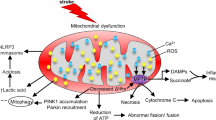Abstract
Evidence indicates that neural stem cells (NSCs) can ameliorate cerebral ischemia in animal models. In this study, we investigated the mechanism underlying one of the neuroprotective effects of NSCs: tunneling nanotube (TNT) formation. We addressed whether the control of cell-to-cell communication processes between NSCs and brain microvascular endothelial cells (BMECs) and, particularly, the control of TNT formation could influence the rescue function of stem cells. In an attempt to mimic the cellular microenvironment in vitro, a co-culture system consisting of terminally differentiated BMECs from mice in a distressed state and NSCs was constructed. Additionally, engraftment experiments with infarcted mouse brains revealed that control of TNT formation influenced the effects of stem cell transplantation in vivo. In conclusion, our findings provide the first evidence that TNTs exist between NSCs and BMECs and that regulation of TNT formation alters cell function.





Similar content being viewed by others
References
Ciccone A et al (2013) Endovascular treatment for acute ischemic stroke. N Engl J Med 368:904–913. doi:10.1056/NEJMoa1213701
Stone LL, Grande A, Low WC (2013) Neural repair and neuroprotection with stem cells in ischemic stroke. Brain Sci 3:599–614. doi:10.3390/brainsci3020599
Maciaczyk J, Singec I, Maciaczyk D, Klein A, Nikkhah G (2009) Restricted spontaneous in vitro differentiation and region-specific migration of long-term expanded fetal human neural precursor cells after transplantation into the adult rat brain. Stem Cells Dev 18:1043–1058. doi:10.1089/scd.2008.0346
Sakata H et al (2012) Interleukin 6-preconditioned neural stem cells reduce ischaemic injury in stroke mice. Brain J Neurol 135:3298–3310. doi:10.1093/brain/aws259
Mudo G et al (2009) The FGF-2/FGFRs neurotrophic system promotes neurogenesis in the adult brain. J Neural Trans 116:995–1005. doi:10.1007/s00702-009-0207-z
Hankey GJ, Eikelboom JW (1999) Homocysteine and vascular disease. Lancet 354:407–413. doi:10.1016/s0140-6736(98)11058-9
Marzo L, Gousset K, Zurzolo C (2012) Multifaceted roles of tunneling nanotubes in intercellular communication. Front Physiol 3:72. doi:10.3389/fphys.2012.00072
Rustom A, Saffrich R, Markovic I, Walther P, Gerdes HH (2004) Nanotubular highways for intercellular organelle transport. Science 303:1007–1010. doi:10.1126/science.1093133
Plotnikov EY et al (2008) Cell-to-cell cross-talk between mesenchymal stem cells and cardiomyocytes in co-culture. J Cell Mol Med 12:1622–1631. doi:10.1111/j.1582-4934.2007.00205.x
Acquistapace A et al (2011) Human mesenchymal stem cells reprogram adult cardiomyocytes toward a progenitor-like state through partial cell fusion and mitochondria transfer. Stem Cells 29:812–824. doi:10.1002/stem.632
Bloemendal S, Kuck U (2013) Cell-to-cell communication in plants, animals, and fungi: a comparative review. Naturwissenschaften 100:3–19. doi:10.1007/s00114-012-0988-z
Koyanagi M, Brandes RP, Haendeler J, Zeiher AM, Dimmeler S (2005) Cell-to-cell connection of endothelial progenitor cells with cardiac myocytes by nanotubes: a novel mechanism for cell fate changes? Circ Res 96:1039–1041. doi:10.1161/01.RES.0000168650.23479.0c
Figeac F et al (2014) Nanotubular crosstalk with distressed cardiomyocytes stimulates the paracrine repair function of mesenchymal stem cells. Stem Cells 32:216–230. doi:10.1002/stem.1560
Hase K et al (2009) M-Sec promotes membrane nanotube formation by interacting with Ral and the exocyst complex. Nat Cell Biol 11:1427–1432. doi:10.1038/ncb1990
Bonner JF, Haas CJ, Fischer I (2013) Preparation of neural stem cells and progenitors: neuronal production and grafting applications. Method Molecul Biol 1078:65–88. doi:10.1007/978-1-62703-640-5_7
Connolly ES Jr, Winfree CJ, Stern DM, Solomon RA, Pinsky DJ (1996) Procedural and strain-related variables significantly affect outcome in a murine model of focal cerebral ischemia. Neurosurgery 38:523–531, discussion 532
Hata R et al (1998) A reproducible model of middle cerebral artery occlusion in mice: hemodynamic, biochemical, and magnetic resonance imaging. J Cereb Blood Flow Metabol Offic J Int Soc Cereb Blood Flow Metabol 18:367–375. doi:10.1097/00004647-199804000-00004
Chen CC et al. (2014) A forced running wheel system with a microcontroller that provides high-intensity exercise training in an animal ischemic stroke model. Braz J Med Biol Res 47:858–868. doi:10.1590/1414-431X20143754
Gurke S, Barroso JF, Gerdes HH (2008) The art of cellular communication: tunneling nanotubes bridge the divide. Histochem Cell Biol 129:539–550. doi:10.1007/s00418-008-0412-0
Suksuphew S, Noisa P (2015) Neural stem cells could serve as a therapeutic material for age-related neurodegenerative diseases. World J Stem Cell 7:502–511. doi:10.4252/wjsc.v7.i2.502
Stenudd M, Sabelstrom H, Frisen J (2015) Role of endogenous neural stem cells in spinal cord injury and repair. JAMA Neurol 72:235–237. doi:10.1001/jamaneurol.2014.2927
Austefjord MW, Gerdes HH, Wang X (2014) Tunneling nanotubes: diversity in morphology and structure. Commun Integ Biol 7, e27934. doi:10.4161/cib.27934
Minuth WW, Denk L (2015) When morphogenetic proteins encounter special extracellular matrix and cell-cell connections at the interface of the renal stem/progenitor cell niche. Anatom Cell Biol 48:1–9. doi:10.5115/acb.2015.48.1.1
Abounit S, Zurzolo C (2012) Wiring through tunneling nanotubes–from electrical signals to organelle transfer. J Cell Sci 125:1089–1098. doi:10.1242/jcs.083279
Lee JY (2014) New and old roles of plasmodesmata in immunity and parallels to tunneling nanotubes. Plant Sci Int J Exp Plant Biol 221–222:13–20. doi:10.1016/j.plantsci.2014.01.006
Zhang J, Zhang Y (2013) Membrane nanotubes: novel communication between distant cells. Sci China Life Sci 56:994–999. doi:10.1007/s11427-013-4548-3
Luchetti F et al (2012) Fas signalling promotes intercellular communication in T cells. PLoS One 7, e35766. doi:10.1371/journal.pone.0035766
Mulrooney DA, Blaes AH, Duprez D (2012) Vascular injury in cancer survivors. J Cardiovasc Transl Res 5:287–295. doi:10.1007/s12265-012-9358-7
Ohno H, Hase K, Kimura S (2010) M-Sec: emerging secrets of tunneling nanotube formation. Commun Integ Biol 3:231–233
Gerdes HH, Rustom A, Wang X (2013) Tunneling nanotubes, an emerging intercellular communication route in development. Mech Dev 130:381–387. doi:10.1016/j.mod.2012.11.006
Acknowledgments
This work was supported by the National Natural Science Foundations of China (81230027, 81070959, 81471219), the Outstanding Subject Leaders Project of Shanghai (14XD1403400), Technology Support Project of Shanghai (14140903300), and the Science Committee Animal Project of Shanghai (13140903400).
Conflicts of Interest
The authors of this manuscript have no conflicts of interest.
Author information
Authors and Affiliations
Corresponding authors
Additional information
Xiaoqing Wang and Xiaowen Yu devoted equally to this work.
Electronic supplementary material
Below is the link to the electronic supplementary material.
ESM 1
(DOC 64 kb)
Rights and permissions
About this article
Cite this article
Wang, X., Yu, X., Xie, C. et al. Rescue of Brain Function Using Tunneling Nanotubes Between Neural Stem Cells and Brain Microvascular Endothelial Cells. Mol Neurobiol 53, 2480–2488 (2016). https://doi.org/10.1007/s12035-015-9225-z
Received:
Accepted:
Published:
Issue Date:
DOI: https://doi.org/10.1007/s12035-015-9225-z




